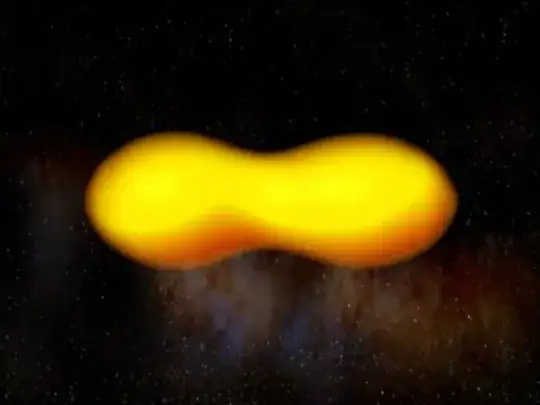Probably not.
A direct quote from here would be nice, but I'm not sure if there's any relevant copyright on the text, so I'll just summarize. Here are the steps to forming a contact binary star system:
- A binary star system forms
- After billions - perhaps only millions, in larger stars - of years, one of the stars becomes a giant.
- The giant grows and grows until its outer layers reach its Roche Lobe.
- One of two things can happen: If the other star, too, is large, the stars may quickly form a contact binary. If the other star is small, matter transfer from the larger star to the smaller star may take place and then a contact binary may form.
Here's why I don't think this could happen in planetary systems:
- Planets don't grow much once they become full-fledged planets. They can shrink and release energy via the Kelvin-Helmholtz mechanism, but they generally can't grow. They can grow when they're in the protoplanet stage, or when they've just reached planethood - whenever that happens - and are still accreting excess material
- Gas giants generally collect all the gas in their immediate area. This means that its more likely that one will form first and take all the gas from another . . . unless matter transfer happens, as detailed above.
- There are a lot of collisions among protoplanets. It's unlikely that two massive planets will form near one another without colliding. They'll each have sustained collisions with other protoplanets and planetesimals; I would think these collisions should make them be at a higher risk for collision with each other.
- Gas giants often migrate from the outer reaches of the stellar system, so in their early days, their orbits may be unstable.
Maybe a temporary common envelope could form at some point, though the system would be unstable.
We can calculate the approximate radius of the Roche lobe. Let's assume that the planets are both the same mass, so $M_1=M_2$ and $\frac{M_1}{M_2}=1$. Given the distance between the planets to be $A$, the radius of the Roche Lobe $r_R$ is
$$r_R=\left(0.38+0.2 \log \frac{M_1}{M_2} \right) A$$
$$r_R=(0.38+0)A$$
$$r_R=0.38A$$
Let's say that the gas giants are just large enough and close enough that they reach the outer edges of their Roche lobes. We'll also say that they are about the same mass and radius as Jupiter.
$$r_R=r_J=0.38A$$
$$A=2.61R_J$$
That's problematic, because we can also calculate the Roche limit of the planets - the point at which one will be torn apart by the other. In this case, the more massive of the two has a mass $M_p$, and the less massive has a mass $M_2$.
$$d=1.26 R_J \left(\frac{M_p}{M_s} \right) ^{\frac{1}{3}}$$
$$d \approx. 1.26R_J$$
So they're way to close! The more massive one will tear the less massive one apart - in essence, they'll collide.
Regarding what TimB wrote in the bounty - I don't have the expertise necessary to do an analysis like that, so I'll leave that to someone else. I wouldn't be able to do it as well as it deserves.
